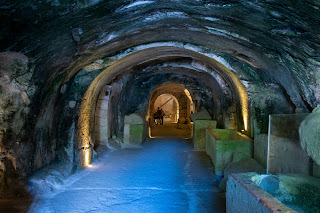Of all the things I thought I'd see at Megiddo, rainbows weren't one of them.
Going to Megiddo was a big deal for me, because when I was on my Bible tour in 2017, we only went inside the visitor's center. It was a busy day, and there wasn't time for us to tour it, so he just showed us a model of it and explained it all. NOT THE SAME THING!!! Coupled with some intense jet lag, I honestly didn't care.
Since returning to Israel, Megiddo has been at the top of my list of 'new' places to visit. And finally, the day came. After days of rain, the sky cleared and we headed out to the Jezreel Valley... only for the sky to open up again once we got there. Such a disappointment! We tried to wait it out, but then finally decided to leave. But first, we stopped at the gas station... and then the rain stopped.... a beautiful, vibrant rainbow covered the valley. "Quick! Let's go back to Megiddo!" my friend said.
We were so glad we did!
Megiddo was a significant place in the Jezreel Valley's history, because it guarded the Via Maris, the pass through the valley that was necessary for all trade to travel from Egypt and Asia minor. Its history dates back millennia. In fact, there are more than 26 layers of civilization in the tel that makes the site. WOW!!! That's enough to make this history nerd see stars, haha.
Its history dates back to the Early Bronze Era (3000-3500 BC), and the remains of an excavated temple are "the most monumental single edifice so far uncovered from the Early Bronze Age" (
find out more here).
In the Middle Bronze Age (1000's BC), urban planning came into play. And in the Late Bronze Age, after a war won by King Thutmose III, a massive palace was built.
The city gates from the Canaanite period (above) versus from Solomon's era (below). Can you see the difference? The wood beams denote where the original walls still stand and what is part reconstruction for context.
Around 1150 BC, it was settled by the Israelites. But then a fire moved through. Built back up and fortified by Solomon, it remained in Israel control until the Assyrians moved through in 732 BC, and by 586 BC, when the Babylonians came through, it was abandoned.
This grain silo dates back to King Jeroboam!
Upon the writing of Revelation in AD 96, Megiddo is mentioned again, this time in Greek. It is incorrectly translated from "Har Megiddo" (Mount Megiddo) to "Armageddon" in Revelation 16:16, talking about a final battle for Jerusalem.
So this place is incredibly important!
Like I said, I want to go back and explore the water system when it isn't raining. So with that in mind, my two favorite things (so far) about Megiddo are:
1. THE VIEW! I mean, #IsraelorIreland, am I right?
and
2. The Stables
There were 2 stables, one in the north and one in the south. I love how these are set up with the images of horses. And you definitely can't beat the view!
So fun! I know I didn't even begin to learn all there is to discover about Megiddo. I can't wait to go back!






























































